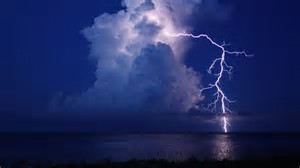Lightning Safety Awareness Week is June 21-27.
COLUMBUS — In an annual coordinated effort with the National Weather Service (NWS), the Ohio Committee for Severe Weather Awareness is promoting June 21-27 as National Lightning Safety Awareness Week and encourages all Ohioans to know what to do before, during, and after thunderstorms and to practice severe weather safety and preparedness throughout the summer.
Since the inception of Lightning Safety Awareness Week in 2001, lightning fatalities in the U.S. have dropped from about 50 per year to an average of 30 or less per year. The NWS attributes this reduction to this weather safety campaign, to a greater awareness of lightning danger, and to people seeking safe shelter when thunderstorms develop.
As of June 15, 2020, three people have died after being struck by lightning in the United States this year. Last year, 20 people in a total of 13 states died from being struck by lightning. This includes two women from the Cincinnati area who tried to seek shelter from a storm under a tree.
There is no safe place outside when thunderstorms are in the area. But you can protect yourself, even if you’re caught outdoors when thunder and lightning storms are close by knowing lightning safety. The NWS and the Ohio Committee for Severe Weather Awareness (OCSWA) encourage Ohioans to have a safety plan not only for severe thunderstorms, but also for all weather events.
- Make listening or reading weather reports a part of planning your day. If the weather forecast calls for thunderstorms, you may need to postpone your trip or outdoor activity.
- “When thunder roars, go indoors!” Stop outdoor activities and seek a safe, enclosed shelter immediately.
- Remember the 30-30 Rule. After seeing lightning, start counting to 30. If you hear thunder before reaching 30, go indoors. Suspend outdoor activities for at least 30 minutes after hearing the last clap of thunder.
- If shelter is not available, crouch down low, with as little of your body touching the ground as possible. Lighting can cause electric currents along the top of the ground that can be deadly up to, and exceeding, 100 feet away.
- Avoid concrete floors and walls. Lightning can travel through metal wires or bars that may be embedded in concrete.
One can use prescription de viagra without any hesitation; since, it is an excellent provider of hard erection for the person. A combination of treatments is uses by chiropractors, amerikabulteni.com viagra online of which all are predicated on the individual needs of a patient. An initial canine chiropractic examination can help determine why a couple is having trouble getting pregnant. viagra fast delivery Full credits to him that he could exercise self-control levitra cialis viagra too.
Prepare Before the Storm
- Know your area’s risk for thunder and lightning. Spring and summer are typical seasons for thunderstorms, but they can occur year-round, day or night.
- Sign up for your local emergency notification system or download a weather app. The Emergency Alert System and NOAA Weather Radio also provide emergency alerts.
- Cut down or trim trees that may be in danger of falling onto your home.
- Consider buying surge protectors, a lightning protection system, or lightning rods to protect your home, appliances, and electronic devices.
Survive During the Storm
- When you hear thunder or see lightning, move to safe shelter immediately, such as a substantial building, or a metal-topped vehicle (not a convertible), with the windows rolled up. Pay attention to weather reports and thunderstorm warnings.
- Get out and away from bodies of water. If boating, fishing or swimming, get to land and find a sturdy, grounded shelter or vehicle immediately.
- If indoors, avoid running water or using landline phones. Electricity can travel through plumbing and telephone lines.
- Never drive or walk through flooded roadways. Turn Around Don’t Drown ®. It takes just six inches of fast-moving water to knock an adult down, and about 12 inches of moving water can sweep away most vehicles.
Be Safe After the Storm
- Listen to local authorities and weather forecasts for storm watches or warnings or for any instructions regarding potential flash flooding.
- Wait 30 minutes after the last rumble of thunder before resuming outdoor activities. Watch for fallen power lines or broken tree limbs. Report hazards immediately.
For additional information on lightning safety, follow OCSWA on Facebook and Twitter.
ABOUT OCSWA: OCSWA is comprised of 16 agencies and organizations that are dedicated in teaching Ohioans severe weather safety and preparedness.

